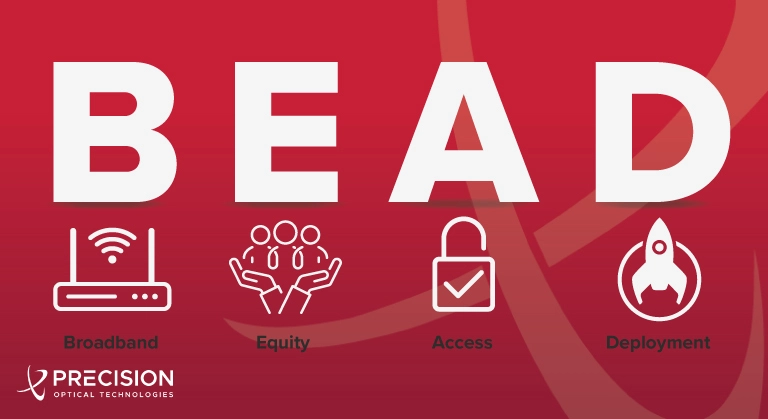
Analyzing the BEAD Program’s Challenges and Opportunities for Broadband Providers

It’s the most wonderful time of year again. Everyone’s children are back in school, and you finally have a bit more time for yourself. In other words, it’s time to think about your broadband plans for the rest of the year and into 2024. As we’ve done in the past with RDOF, today, we’re looking at another federal grant program aimed at expanding broadband connectivity across the U.S. and five territories – the Broadband Equity, Access, and Deployment (BEAD) Program. We’re excited about this program. It’s set to foster greater partnerships between local governments and broadband providers, helping put an end to America’s digital divide. That said, some industry analysts are concerned that high optical network equipment costs could end up slowing down BEAD-funded deployments. We’re here to say that these challenges do have solutions.
What is the BEAD Program?
Funded by the Bipartisan Infrastructure Law, the BEAD Program provides $42.45 billion to expand high-speed internet access in all 50 states, Washington D.C., and the following 5 U.S. territories, including Puerto Rico, the U.S. Virgin Islands, Guam, American Samoa, and the Commonwealth of the Northern Mariana Islands. It’s a part of the federal government’s wider $65 billion Infrastructure Investment and Jobs Act (IIJA).
The BEAD Program provides grants in a lump sum to each of these jurisdictions based on the number of underserved households in each state, district or territory. Basically, BEAD prioritizes two key groups:
- Unserved locations that have no internet access or very limited access under the 25 Mb/s download and 3 Mb/s upload threshold
- Underserved locations that have access at the 25 Mb/s download and 3 Mb/s upload threshold but speeds of no more than 100 Mb/s download and 20 Mb/s upload.
All BEAD funded broadband projects must reach a minimum of 100/20 Mbps with a latency of less than or equal to 100 milliseconds. While every state and territory is a winner, how the money has been allocated tells an interesting story. Although Texas has won the most amount of funding overall ($3.3 billion in funds), breaking the allocation down on a per household basis reveals that Alaskan households have each won the lions share at roughly $4,000 per household. In places like Wyoming, West Virginia and Montana, each household has been awarded less than half that amount at around $1,500 per household.
The need for funds is clearly very high in America’s more rural locations. Once all BEAD-funded projects are complete, the people living in these areas will have a wealth of new opportunities for employment, education and recreation at their fingertips, enabling them to engage in exciting new ways with their fellow citizens across the vast American footprint.
As each state, district or territory begins submitting plans as to how they will use their funds to build the broadband infrastructure needed to upgrade service in the areas the program is targeting, a few key elements of the BEAD Program’s rules deserve some extra attention.
Once Again, Fiber is King, but a Gauntlet of Challenges Could Slow Deployments Down
When it comes to bridging the digital divide under BEAD, industry analysts expect new fiber networks to be a preferred solution although plenty of room exists for cable, especially since it serves around 60% of the U.S. broadband market. As with RDOF, different broadband providers will choose the network solutions that best work for them, including various Fiber-to-the-Home (FTTH), passive optical network (PON), and hybrid fiber/coax (HFC) architectures. But here’s a catch.
Coded into the IIJA is the White House’s Build America, Buy America provision (BABA), which places two strict requirements on federally funded projects. First, 55% of the component cost must be spent with American suppliers and second, materials must be manufactured in the United States. For broadband providers interested in BEAD funding, these requirements pose a particular challenge. While fiber-optic networks are expected to be a vital part of most BEAD projects, the equipment that they rely on (i.e., routers, switches, gateways, semiconductors, etc.) has multiple core components that are not made in the U.S. at scale. As New Street Research analyst and former FCC official Blair Levin has said, reshoring the facilities needed to manufacture these components could “take years, with no guarantee that private enterprises will agree to do so.” Even though the National Telecommunications and Information Administration (NTIA) has proposed a waiver that would ease these requirements for broadband providers, there are other pervasive challenges (high equipment costs, vendor lock, long lead times, supply chain challenges, etc.) that could impact the ease of BEAD-funded broadband projects. Fortunately, there is a solution!
How Precision OT Can Support Bead-Funded Projects
Working with us gives you, the broadband provider, all types of significant benefits. When it comes to high equipment costs, vendor lock, long lead times and supply chain challenges, we can help. With PON and fiber no longer “taboo” words for cable operators (many are open to multi-technology approaches to excel as market leaders) and surging access network operator interest in technologies that can help them save on capex and opex (like tunable optics), it’s clear that everything revolves around customization, interoperability and doing more with less.
Here at Precision OT, we believe in providing high-quality, custom and interoperable solutions backed by advanced, consultative engineering expertise across the design, testing and implementation of the network solutions you procure from us. We work closely with you to understand your network needs. Through a mix of cutting-edge programming, diagnostics and testing technologies in our lab and at our customer facilities, we create high-quality optics that are compatible with one or perhaps multiple host platforms within your network. Accomplishing this is no easy feat, requiring careful systems engineering know-how. Learn more about what kind of expertise our engineers offer here.
But it’s more than just transceivers we make. We’ve also been working hard to turn Precision OT into a setting where our customers can come and find anything they might need for their broadband deployments. That includes a plethora of optical passives, including mux/demux filters and optical splitters, as well as connectivity equipment like MPO breakout modules, MPO/MTP cable and fiber jumpers. We also offer a variety of tuning modules and an associated tuning software package as well as rack and wall mount hardware. Visit our product page for more information.
Bringing it all back to BEAD, one of our more recent, all-encompassing solutions is OpenPath™, an all-inclusive, turnkey PON solution that eliminates vendor-lock and provides you with the agile, responsive, in-depth technical support you need. OpenPath™ is a comprehensive solution, encompassing all critical PON components like Optical Line Terminals (OLTs), optics, splitters, Optical Network Units (ONUs) and cutting-edge controller software. It’s everything you need from one point of contact. Because we’ve embraced a white box hardware model in designing our systems, you can integrate a diverse array of ONUs and ONTs in your network the way you want. You’re no longer limited to closed, proprietary solutions that could force you to contend with long lead times, high equipment costs, slow time to market and limited upgrade paths (to other form factors or future PON technologies). For network operators looking to leverage BEAD funds for PON deployments and set themselves up for success down the line, OpenPath™ could be just the solution they’re looking for. Visit our OpenPath™ landing page for more vital information.
Lastly, as the government considers the NTIA waiver that could relax certain BABA requirements for network operators, it’s also helpful to remember that Precision OT is compliant with the Trade Agreements Act (TAA). While the TAA and BABA are two different pieces of legislation, we’ve always paid special attention to ensuring that each product we offer has been substantially altered in the United States into a new or different article of commerce with “a name, character, or use distinct from that of the article or articles from which it was transformed.” So, if the winds of change blow in the direction of relaxing stringent BABA requirements, Precision OT is already TAA-compliant. It remains to be seen how that could factor into wider BEAD-funded deployments, but it’s worth keeping in mind.
Are you looking for assistance with a BEAD-funded broadband rollout? Are you considering FTTH, HFC, PON or any other type of network architecture? Are high equipment costs, supply chain issues and long lead times keeping you up at night? If so, contact us today and we can start making your life simpler.






